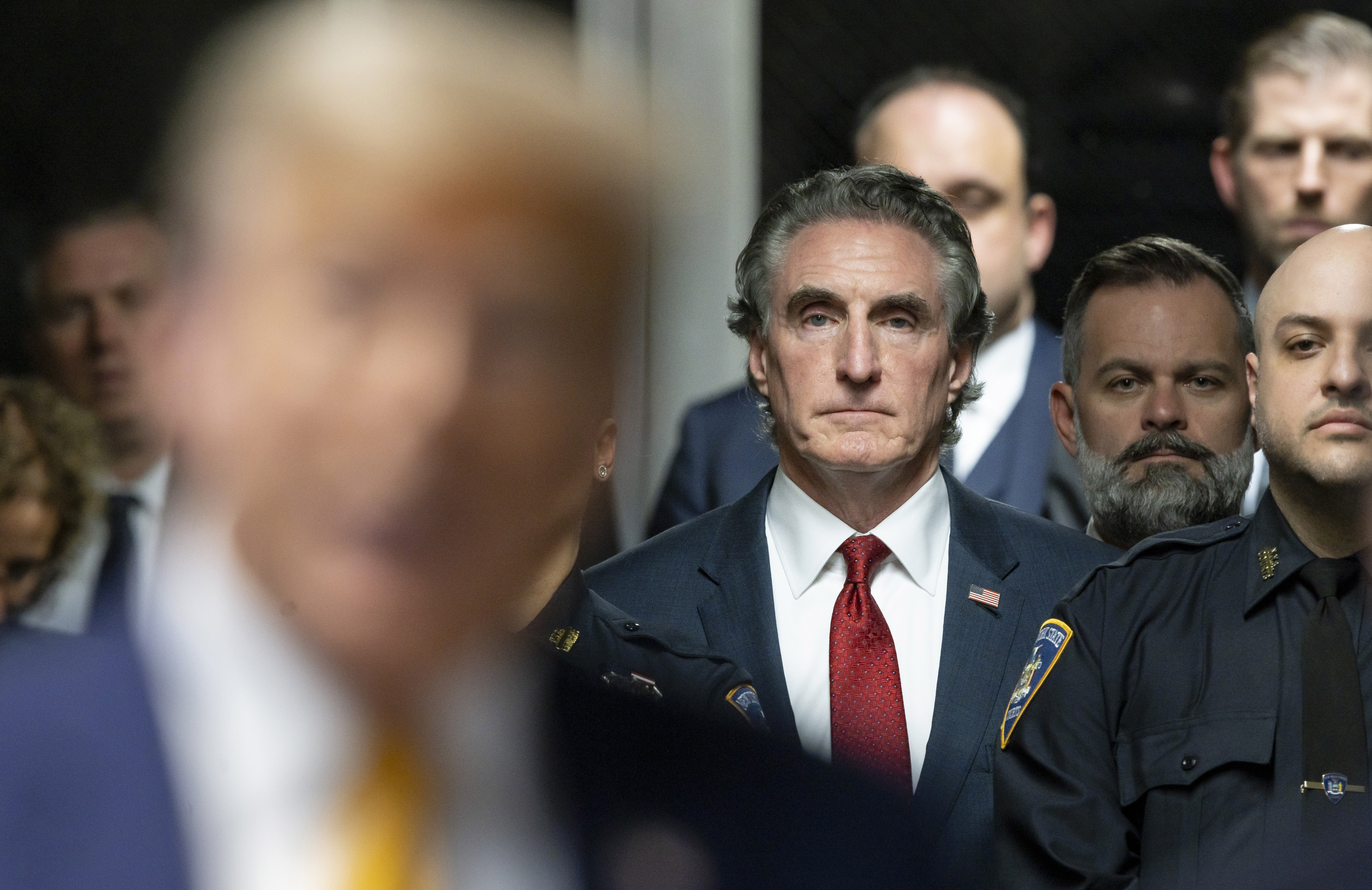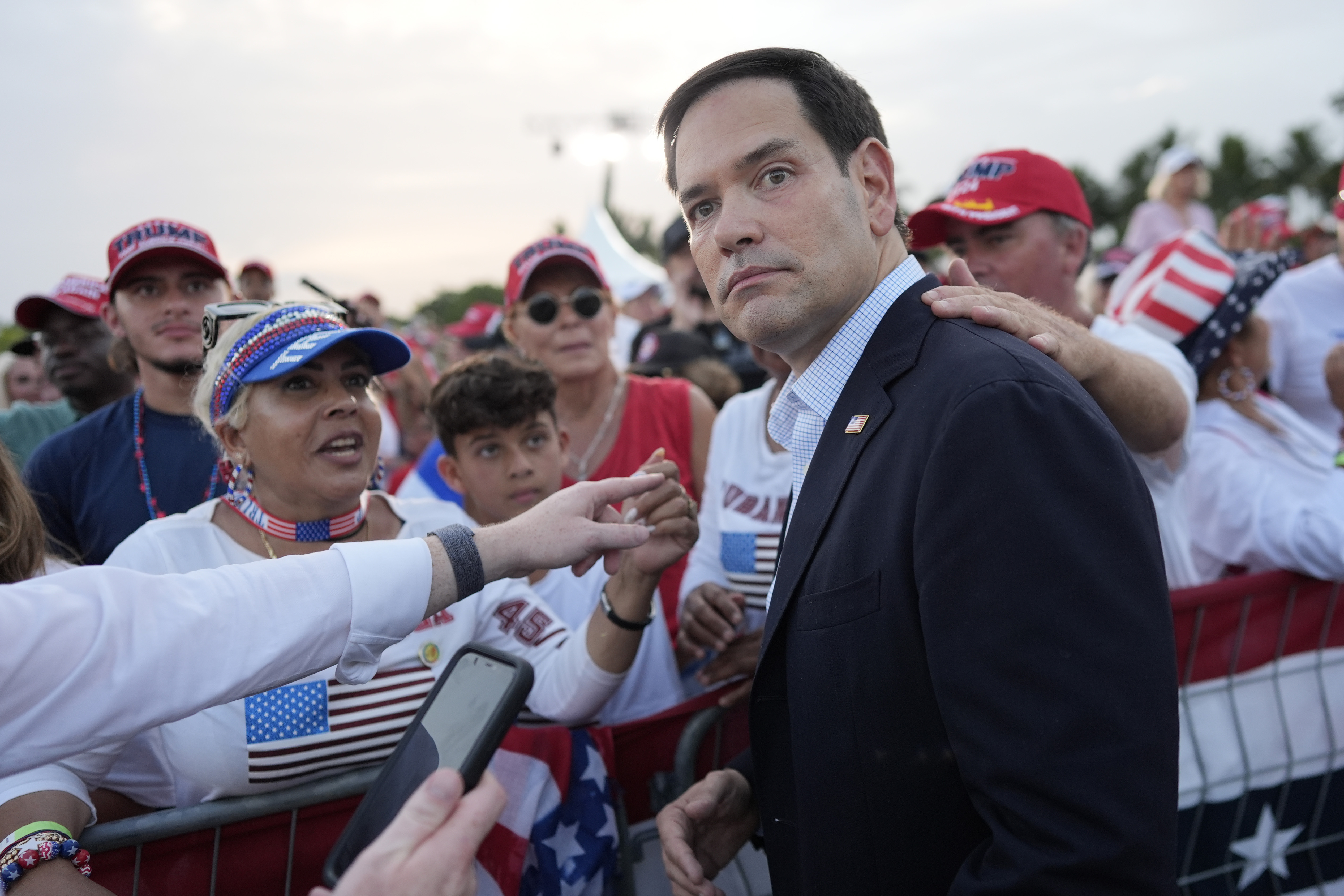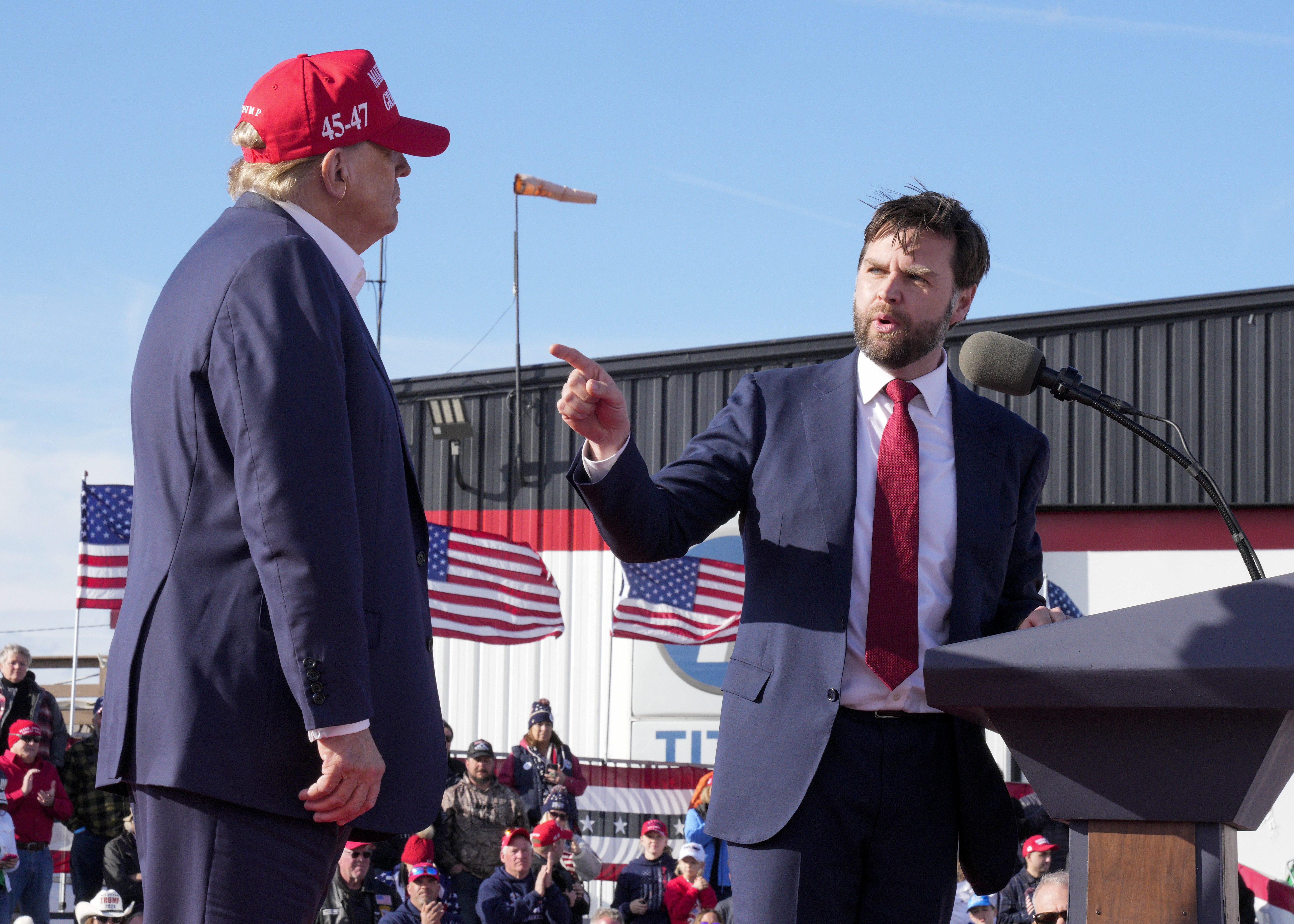Former President Donald Trump is expected in the coming days to name his running mate, and none of the likely choices is anything close to a climate champion.
There are, however, subtle differences among the candidates Trump could tap as vice president if he reclaims the White House. One possibility — North Dakota Gov. Doug Burgum — has even set a goal for his state to become carbon-neutral.
Many of Burgum’s Republican rivals serve in Congress: Sens. J.D. Vance of Ohio and Marco Rubio of Florida are two top contenders. Sen. Tim Scott of South Carolina and Rep. Byron Donalds of Florida are two others.
But Trump long has shown a flair for surprise and showmanship, and political observers say it’s possible the presumptive Republican nominee for president plucks someone else entirely.
Even so, it’s unlikely any running mate would stray far from either Trump or the Republican party platform. Trump has long rejected and mocked climate science, and the Republican party platform does not mention climate change at all — and emphasizes support for the fossil fuel industry.
Here’s how the candidates compare.
Gov. Doug Burgum of North Dakota

Burgum, a former tech executive, came into office with no energy sector experience but since has become a go-to source for Trump on energy policy.
Known for his connections with wealthy oil executives and GOP donors such as Harold Hamm, CEO of Continental Resources, Burgum has emerged as a vocal critic of the Biden administration’s efforts to tackle climate change.
Speaking last month alongside other GOP governors at a news conference outside a Louisiana oil refinery, Burgum characterized the Biden’s climate efforts as an attempt to “shut down liquid fuels in America.”
“If you’re on team EV, you’re on team China,” he said.
But unlike Trump, who has referred to climate change as a “hoax,” Burgum has been less combative on the issue itself — opting instead to avoid talking about fossil fuels and their role in driving climate change.
“In North Dakota politics, you do not survive unless you are a very strong supporter of maximum oil and gas production,” said Barry Rabe, a political science professor at the University of Michigan.
A spokesperson for his office, Mike Nowatzki, didn’t respond to an email seeking to clarify the governor’s position.
Yet Burgum has set a goal of making North Dakota carbon-neutral by the end of the decade — an announcement he unveiled at the Williston Basin Petroleum Conference in 2021. That would be a decade and a half sooner than California.
How would he do it? By going all in on carbon capture and storage — a technology the Biden administration also supports and is at the heart of EPA’s proposed rule to slash power plant carbon emissions.
The Biden administration sees carbon capture as one of many climate solutions, alongside efforts to cut emissions from power plants and tailpipes. Burgum, however, eschews mandates and said “innovation, not regulation” can keep the state’s extraction economy humming.
Under Burgum, North Dakota became the first state granted primacy by EPA to oversee specialized injection wells for CO2, and the state is the endpoint for pipeline developer Summit Carbon’s planned $8 billion project to transport CO2 from dozens of Midwest ethanol plants.
While the governor’s carbon-neutral goal draws eyerolls from climate advocates, his supporters say Burgum has skillfully led the state through a challenging environment for fossil fuels.
“People pick at him for not talking about climate change, but these are people who, for the most part, only want to talk about climate change,” said Jason Bohrer, CEO of North Dakota’s Lignite Energy Council. “They don’t want to talk about economic growth or energy diversity.”
Bohrer credits the governor for making himself a “legit energy expert” since taking office in 2016 as well as for helping save the state’s largest coal-burning power plant — the 1,151-megawatt Coal Creek Station — from closure in 2022 by working alongside members of the state’s congressional delegation and others to find a buyer.
Today, the plant’s new owners, North Dakota-based Rainbow Energy, said they’re investing in carbon capture equipment at the plant with the help of $38 million in DOE funding. The aim is to make 90 percent of the plant’s output carbon-free.
Frank Maisano, a senior principal at Bracewell LLP, said Burgum’s time in office demonstrates the breadth of his energy experience.
“I, frankly, hope that Burgum doesn’t get to be the VP. Because I think he would be a great energy secretary,” he said. “He has all of it. I mean, North Dakota is an all-of-the-above state. And you have to be an all-of-the-above guy to work in that state.”
Sen. Marco Rubio of Florida

Rubio catapulted himself to the Senate in 2010 in part by attacking one opponent as “a believer in man-made global warming.”
Rubio since has softened his rhetoric but not his positions.
Elected to a third term in 2022, he has slammed policies to curb emissions as environmentally meaningless and economically fatal. Instead, he supports adaptation projects to “buy time” while companies decarbonize voluntarily.
“These problems are manageable,” he wrote in a 2019 op-ed.
“That doesn’t mean building sea walls around Florida or forcing Americans to move to higher ground,” he added. “Plans stemming from panic will constrain our economy and cripple our ability to invest future resources in solving longer-term issues.”
As one of the Senate GOP’s top foreign policy hands, Rubio has framed climate issues in terms of competition with China. And while most of his climate positions echo mainstream Republicans — for instance, why cut U.S. emissions when Chinese emissions are still rising? — he’s also drilled into trade issues, including the critical minerals needed for the energy transition.
Just this week, Rubio, who serves as vice chair of the Senate Intelligence Committee, introduced a bipartisan bill with Virginia Sen. Mark Warner, the panel’s Democratic chair, aimed at strengthening U.S. supply chains of lithium, cobalt and other rare earth minerals.
“He’s been a crusader on trade issues for a long time,” said Maisano of Bracewell. “That’s where the new climate agenda is.”
No matter who’s in the White House, he added, the next few years of climate policy will be shaped by how much the U.S. can challenge China’s control of critical mineral supply chains.
Separately, Rubio was one of the 69 senators who voted to ratify the Kigali Amendment, part of an international treaty to phase down superpolluting hydrofluorocarbons.
The Floridian has fewer home-state ties to the fossil fuel sector than his rivals from Ohio and North Dakota. The oil and gas industry has donated about $1.7 million to all his federal campaigns, according to OpenSecrets — about as much as the insurance and manufacturing sectors, but far less than his top donors in the finance sector (almost $9.2 million).
Rubio does have close ties to the homebuilders lobby, a sector that has emerged as a key opponent to electrifying buildings.
The industry donated more to Rubio in 2022 — $86,000 — than any other Senate candidate. Then in 2023, according to InsideClimate News, he tried to block federal agencies from tightening energy efficiency standards for the homes they finance. (His effort to add that policy rider to a government spending bill failed on a 47-51 vote.)
Sen. J.D. Vance of Ohio

Vance was once a Trump critic who expressed concern about climate change. But during his successful 2022 Senate run — and now as a top Trump defender — Vance has adopted the former president’s view of climate policy.
In 2020, before he entered politics, Vance told a crowd at Ohio State University that “we of course have a climate problem in our society.”
He blamed China’s greenhouse gas emissions but also said the United States has been slow to green its energy system. He called solar power the “biggest improvement in emissions” and warned of relying too much on gas.
Gas, he said, is an “improvement over dirtier forms of power but isn’t exactly the sort of thing that’s gonna take us to a clean energy future.”
But Vance’s tone has shifted alongside his rise in the Republican party.
In July 2022, he told conservative radio hosts Clay Travis and Buck Sexton that he did not think there was a climate change crisis.
“Even if there was a climate crisis, I don’t know how the way to solve it is to buy more Chinese-manufactured electric vehicles,” he said. “The whole EV thing is a scam, right? So set to the side these questions about, you know, how much carbon drives the climate change situation.”
While in the Senate, Vance has taken up his party’s attacks on climate policy. He has criticized ESG investing and claimed Biden’s climate policy sent American jobs to China.
But Vance’s shifting climate positions isn’t what makes him a top candidate for Trump’s running mate. It’s how he has morphed into ironclad Trump loyalist, said Christopher Devine, a political science professor at the University of Dayton and author of “Do Running Mates Matter? The Influence of Vice Presidential Candidates in Presidential Elections.”
“His loyalty to Trump is exactly what Trump is looking for in a second term,” Devine said.
Honorable mentions
Trump of course could pick someone who has flown under the radar.
The reality star turned politician has been nothing but unpredictable during his time in the national spotlight, and he has kept up that persona in his pursuit of a running mate.
One possibility is Sen. Tim Scott (R-S.C.).
A top recipient of oil and gas money in the 2022 election cycle, Scott has recognized that climate change is occurring, but has downplayed its severity — and he often points to China’s emissions as a reason not to do more to cut domestic carbon output. He has been critical of Biden’s climate policy and claimed it was damaging the U.S. economy.
Another potential candidate is Rep. Byron Donalds (R-Fla.).
Donalds has dismissed the connection between climate change and extreme weather such as heat waves. And he has leaned into climate as a way to attack Democrats — saying this month on Fox News Sunday that Vice President Kamala Harris would fare no better leading the ticket than Biden, because she “fully sponsored the radical Green New Deal.”
Donalds has used his perch on the powerful House Financial Services Committee to assail the Biden administration’s efforts to integrate climate risk into financial regulations.
He’s hammered Wall Street firms for emphasizing ESG standards for their investments. And he called Democratic legislation to mandate corporate disclosures of climate risk “liberal fascism.”
This story also appears in Energywire.
